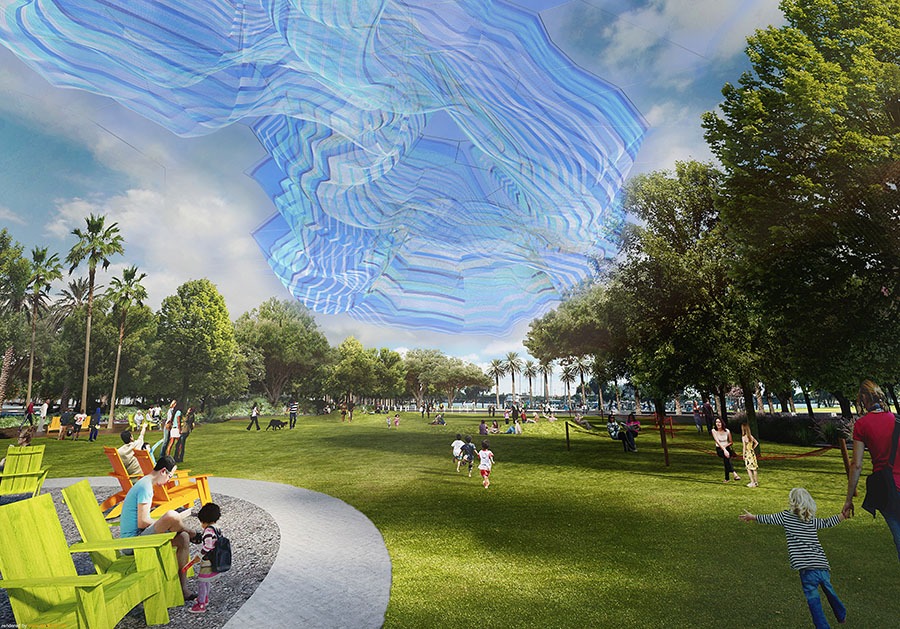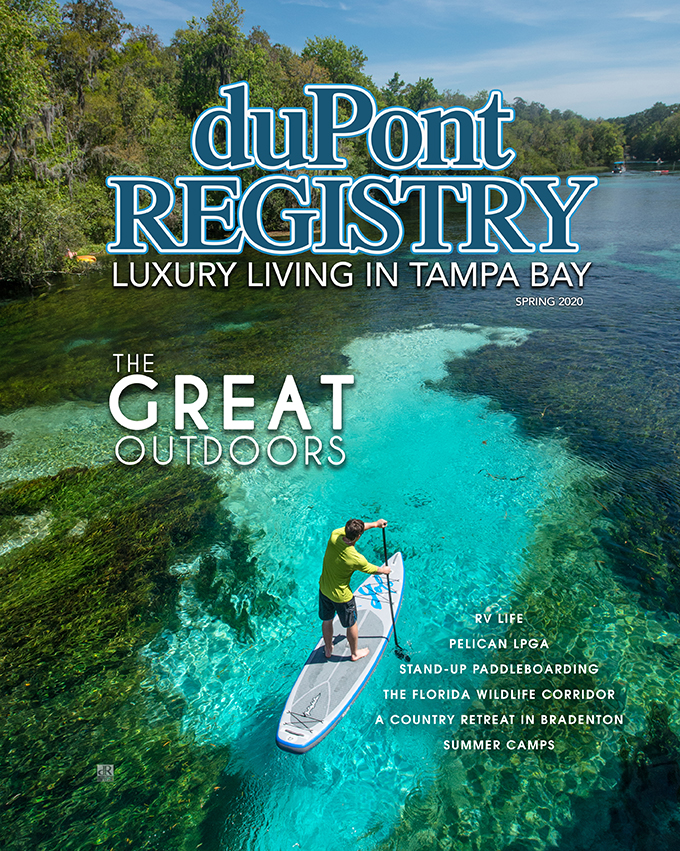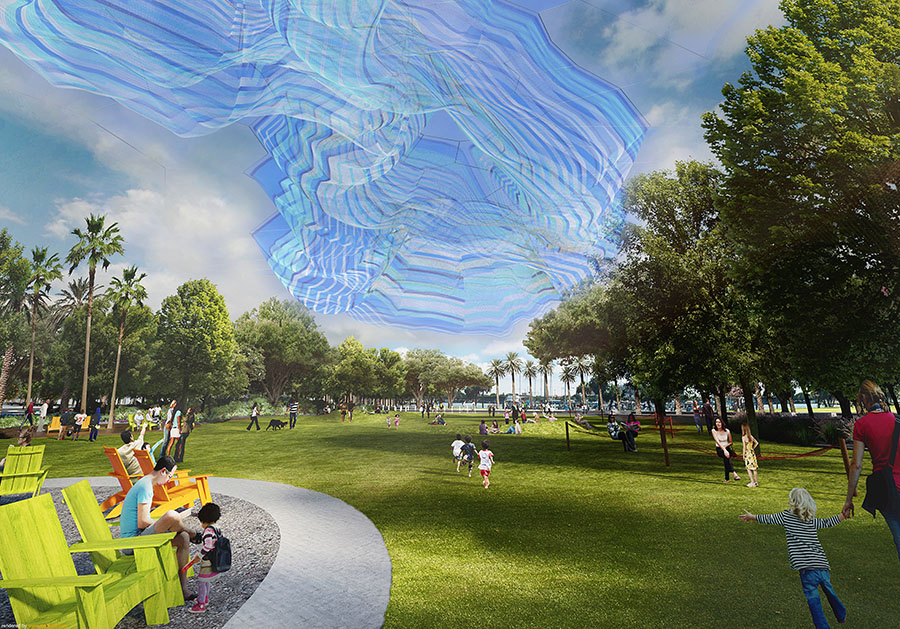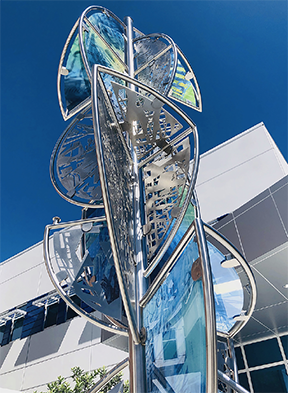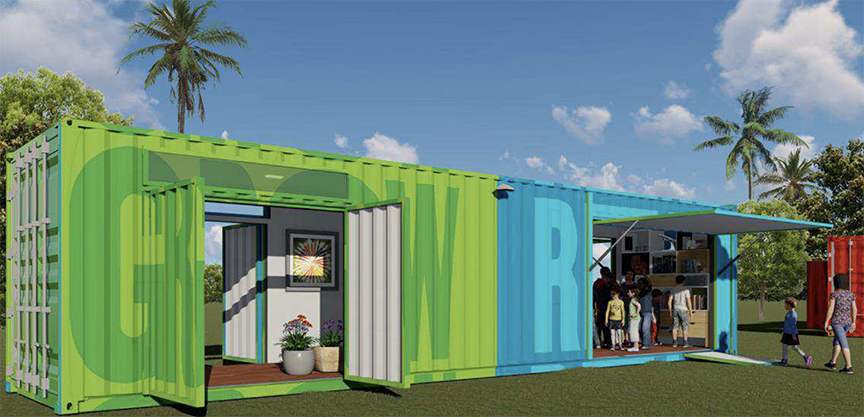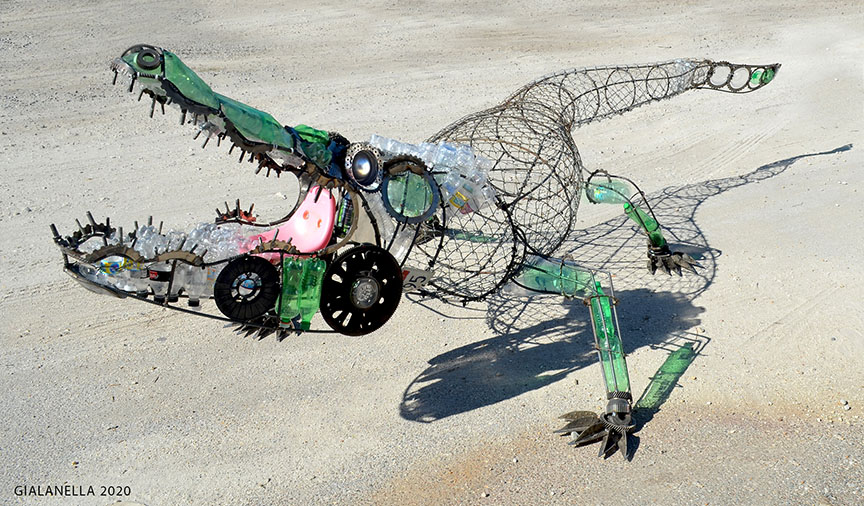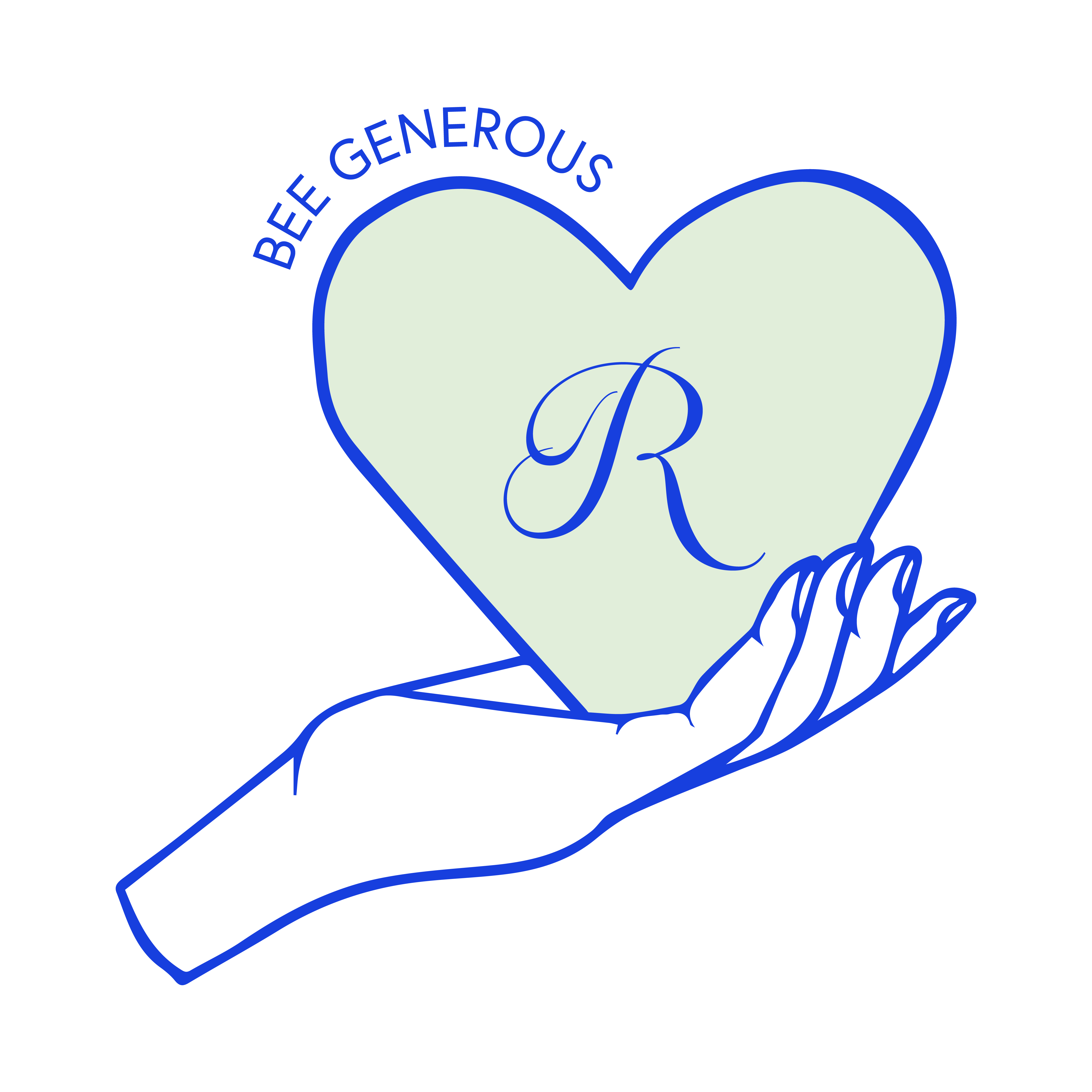Editor’s Note: This story is included in our Spring 2020 “Great Outdoors” issue, which went to press before the restrictions that came with the COVID-19 pandemic. Nevertheless, you won’t be violating any health guidelines if you wander outside by yourself (or a safe distance from your companions) to see the beautiful public artworks Julie Garisto identifies here (including some in progress that we can look forward to once this crisis is over).
Public art has the power to change how we experience an outdoor landscape, and today more and more examples of this unique mode of expression can be seen around Tampa Bay.
Indeed, public art has evolved and splintered into new forms, such as the luminous Lights on Tampa, returning in November with a new installation at the traffic tunnel connecting Platt Street to the Tampa Convention Center. St. Petersburg’s colorful murals have become a major PR hook for the city, remarked upon in every tourist brochure and magazine article about the city’s renaissance.
Starring soon in those brochures: The new St. Pete Pier, which will be home to a wealth of public artworks. The most hotly anticipated of these is the $15-million “Bending Arc.” An aerial sculpture by Boston-based artist Janet Echelman, the Arc is slated to billow above the Pier complex and change shapes in the wind like an astral, psychedelic jellyfish. Echelman, who grew up in Davis Islands, has expressed in past interviews that she creates her large-scale net sculptures to engender a feeling of connection and the enchantment of being a part of something bigger.
Installation of the sculpture has not been without problems, however; work began in January, but when Echelman’s team discovered potential problems related to birds and wildlife, it was shipped to a facility in Washington State for adjustments. (Those changes will be made at no cost to the city, according to Benjamin Kirby, spokesman for the mayor’s office.)
Public art consultant Ann Wykell, the former manager of cultural affairs and international relations for St. Pete, reminds us to take notice of the other works on the grounds of the Pier recreation area, which is due to open May 30.
“I’m really impressed with Nathan Mabry’s red origami-like, 13-foot pelican sculpture, a great representation of St. Petersburg’s official bird,” she said. A committee made up of citizens and city officials unanimously voted in favor of the California artist’s “Myth (Red Pelican),” which will serve as a welcome to visitors at the Pier’s entrance plaza.
Other works include Xenobia Bailey’s “Morning Stars,” a 23-foot-wide and 7-and-a-half-foot high mosaic made up of mandalas in different sizes, shapes and colors, and Belgian artist Nick Ervinck’s “Olnetopia,” a water-like bronze sculpture with a patina finish that will be installed near the Pier Point.
Mark Aeling, whose MGA Studio has created pieces at multiple locations locally and nationally, is working on a life-sized replica of the Benoist Airboat that will be installed at the base of the Pier. The sculpture commemorates the first commercial flight, originating in St. Petersburg in 1914, piloted by Tony Jannus.
In total, says spokesman Kirby, St. Petersburg set aside nearly $2 million for public artwork at the Pier.
Art every day
Mark Aeling was among the artists who took part in the recent exhibit Inside the World of Public Art, curated by Ann Wykell at the downtown St. Petersburg gallery of Florida CraftArt. Both Aeling and Catherine Woods, another artist featured in the exhibit, have created stunning works of public art outside the new St. Petersburg Police Department building.
Woods’s “Community DNA” outside the police department includes lines and shapes originating from photos of the city. The work incorporates elements that resonate with locals. “Visiting the site, learning the historic development of a place, taking photos of the area often informs my artwork,” Woods shared, adding that she aspires to create environments that enhance the daily life of the public.
“The egalitarian nature of public art appeals to me,” she added. “It is a way to bring truth and beauty into the everyday life of people, allowing those who might not get the chance to visit galleries or museums an opportunity to interact with art. This is especially important for children. A positive experience with art early on in life could change their lives — as it did mine —broadening their world view.”
Ready to launch
Some public art projects include but don’t necessarily revolve around the skills of an individual artist. Some are meant to inspire, educate and break down social barriers through a forum of ideas and collaborations.
SPACECraft by Carrie Boucher, Mitzi Gordon and Bridget Elmer is one such example. The winner of Creative Pinellas’s touring exhibition contest repurposes two full-size cargo shipping containers into a modular network of creative, interactive spaces that feature programming on the themes of “Make/Play” and “Read/Grow.”
Changes are in store, however. The first installation was meant to debut in the bayside bedroom community of Oldsmar on Mar. 14, but the launch was cancelled by the city in light of COVID-19 concerns, and future programming has been postponed till further notice. For now, discussions are underway to consider alternatives, including the viability of taking the programming online.
But given that the project is meant to stimulate interaction and reflect community interests, it’s already been a success in Oldsmar, whose residents offered a wealth of ideas for what SPACEcraft could do.
“We thought, ‘Oh, they might come back with a few recommendations,’” Boucher shared during a phone interview. “But the comprehensive lists that they came down with revealed the richness of the cultural offerings in little tiny Oldsmar.”
He’s a natural
The integration of the arts with nature has yielded fascinating ways to encounter public art.
Creative Pinellas merged Florida greenery with contemporary dance when they staged “Our Trail: Performances on the Pinellas Trail.” The nonprofit arts agency escorted us outside again this month — this time right outside their Largo headquarters — to display works by St. Petersburg sculptor Donald Gialanella in the Florida Botanical Gardens. “Gialanella in the Gardens” features welded steel assemblage sculptures interspersed among the fronds and blossoms. “Preserving our natural surroundings in terms of not causing environmental damage is of primary importance to me,” Gialanella shared. “I try to use non-polluting, permanent materials whenever possible — stainless steel, corten steel, stone, and glass.”
An impressive example: The city of Pompano Beach has commissioned Gialanella to create a sculpture that will be installed at the bottom of the ocean and attached to the deck of a shipwreck as part of an artificial reef in late 2020.
Gialanella has also been creating interactive projects for the cities of Fort Myers and Clearwater, based on recycling awareness. “Visitors insert their empty single-use water bottles into the sculptures to complete the design.”
Immerse yourself
Coming up soon on both sides of the bay are examples of what could be called public art theme parks.
Fairgrounds, at The Factory in St. Pete’s Warehouse District, will encompass a 12,000-square-foot immersive art exhibition featuring works by local and international artists, performers, writers, musicians, and storytellers.
In Tampa’s Seminole Heights neighborhood, the multi-media arts collective Crab Devil is planning to create Peninsularium — “one of the largest, collaborative, multi-disciplinary arts efforts that Florida has ever seen”— in affiliation with the contemporary art gallery Tempus Projects, in 2021.
The concept harks back to the roadside attractions of yesteryear and promises to be “a family-friendly cabinet of curiosities ripe with kitsch, bizarre history, and fantastical lore showcasing Florida at its most weird and wild.”
Lively sidewalks
City agencies in Clearwater and Dunedin are spearheading several public art initiatives.
Clearwater displays art by locals in its ongoing Sculpture 360 exhibition on Cleveland Street. Funded through a partnership with the Downtown Development Board, the outdoor exhibition displays sculpture, mostly by locals, including Gialanella’s iconic “Gaia” inspired by the artist’s fascination with the human face and named after the Mother Earth goddess of Greek mythology.
Also helping to brighten up the streetscape are Clearwater Arts Alliance’s vivid signal box wraps, which beautify intersections and promote local artists.
The Clearwater Redevelopment Agency recently workshopped with Ryan Swanson, founder of Urban Conga, to gain inspiration for future interactive exhibits and installations. Last year, Swanson displayed a three-week installation called “Oscillation,” interactive structures that use light and sound and respond to movement, at Station Square Park in Downtown Clearwater.
A few miles north, the city of Dunedin has implemented the Dunedin Public Art Master Plan, a comprehensive document that details goals and guidelines that will enable the city to encourage the growth of arts and cultural life. Dunedin is the first city in Pinellas County to have adopted a municipal and private development public art ordinance under its plan.
Building community
“Art is the soul of our culture, and public art engages the community, connecting people with places, creating identity,” sums up St. Pete sculptor Aeling.
“If you think of the Arch in St. Louis, the Eiffel Tower in Paris or the Bean in Chicago, these objects become identifiers for communities — they are in essence the soul of that community. They help people connect to each other, and when hitting on all cylinders they help us feel connected to something greater than ourselves.
“After all, that’s what community is.”

